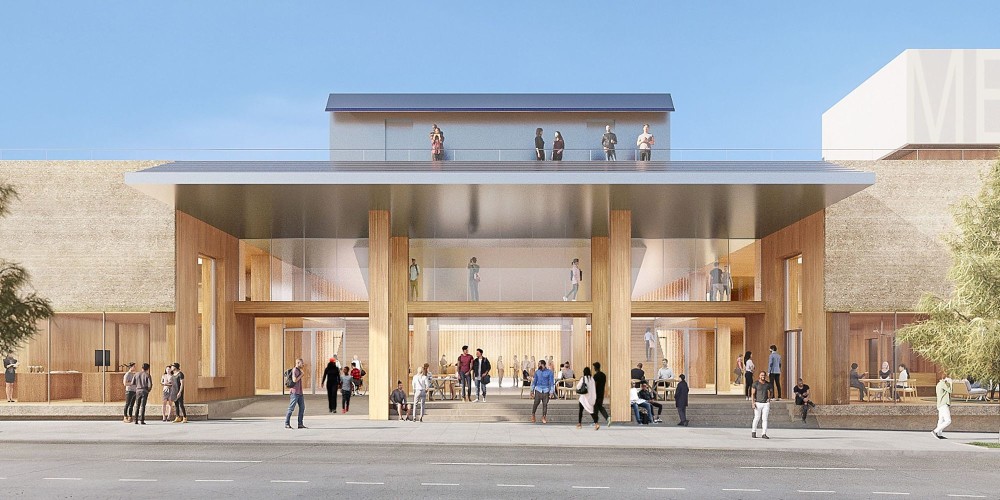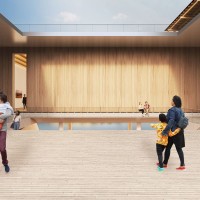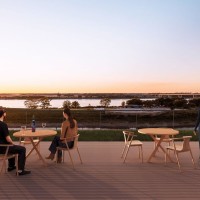The Brooks Memorial Art Gallery opened to the public in 1916. Situated in the center of Memphis within Overton Park, the museum originated as a modest exhibition space without a collection. Over the next one hundred years, additions to the original building expanded the ambition and scale of the institution, transforming it into the present-day Brooks Museum of Art. However, the spatial, climatic, and infrastructural demands of a twenty-first century museum exceeded the capabilities of the existing structures. In 2019 after an extensive selection process, Herzog & de Meuron was appointed design consultant for a new museum building.
A new Brooks located in downtown Memphis will be a key component of the redevelopment of the Mississippi River waterfront. An efficient and sustainable building will serve as a cultural anchor in the historic core of the city. By providing improved and expanded facilities as well as increased access to visitors and proximity to other notable sites downtown, the museum will expand its audience and engage a broader public. Responding to the historic importance of the site and the guiding principles of the foundational plan for the city, the new structure will reinforce and strengthen the existing urban fabric.
Inhabited by both Mississippian and Chickasaw cultures prior to American settlement, Memphis was founded in 1819 with an urban plan that established a grid of orthogonal streets and four distinct public squares. The city is situated atop the fourth Chickasaw bluff along the only natural boat-landing found between the mouth of the Ohio River and Vicksburg, Mississippi. The cliff-like landform of the bluff protects the high ground from flooding, and the nearby landings shelter river traffic from the strong currents of the Mississippi River. Between the edge of the bluff and the leading edge of the urban fabric, the 1819 plan set forth a Public Promenade, an urban amenity unique to Memphis. During the late-nineteenth and early-twentieth century a series of civic structures were built along the Promenade, physical manifestations of the ambition to maintain public use of this elevated land along the Mississippi River. Starting in the 1850’s, the shore of the bluff was paved with cobblestones, creating a river boat landing that played a critical role in the slave economy.
The new Brooks is located at the intersection of Union Avenue and Front Street at the southern end of the historic city core. To the south across Union are some of the oldest buildings in Memphis, modest three-story structures of red brick. To the east along Front Street are brick and concrete warehouses built for the sorting and storage of cotton that arrived from the surrounding Delta. To the north is Cossitt Library, a red sandstone structure and its screened concrete addition. It is one of the earliest public buildings constructed in Memphis. Lastly, to the west beyond Riverside Drive lies the historic Cobblestone Landing, Wolf River Harbor, Mud Island, and the Mississippi River. These four distinct contexts are tied together by the sloping topography of the site. Monroe and Union Avenue mediate between low-lying Riverside Drive and Front Street at the elevation of the city, thirty feet above.
The urban concept for the design proposal centers on the historic importance of the site. Replicating the typical downtown block as a one-story volume, the proposal extends the traditional civic scale of the city along Front Street. Referencing the precedent of downtown alleyways, which divide the surrounding blocks into quadrants, a generous courtyard serves as a central public space in the heart of this newly formed museum block. The unassuming volume of the new structure steps back from the adjacent frontages along Union Avenue and Monroe Avenue to provide generous sidewalks and enlarged view corridors to the west, inviting Memphians back to the riverfront. Drawing pedestrian traffic up along Front Street to the main entrance and the adjacent amenities, the new museum reestablishes the pedestrian connection between Memphis Park, the School of Law, and the Cossitt Library to the north and the bluff walk to the south.
The architectural proposal comprises two main elements: a gallery pavilion and a reconstructed bluff that serves as its sloping base. Together they form one sculptural building that mediates between downtown Memphis and the Mississippi river. The base volume serves as a platform for the public functions of the museum, extending the raised shelf of civic amenities along the river: park, school, library, and museum.
The gallery pavilion is a straightforward, rectilinear volume that frames an interior courtyard. Referencing the natural bluff landscape, the exterior cladding of pavilion and base recalls the warm earthen hues of the exposed clay along the Mississippi River. Inside the pavilion, the timber structure is exposed. Porous and inviting at the Front Street entrance, a shaded entry court and transparent urban living room welcomes all passers-by. The pavilion houses the entrance lobby, temporary exhibition space, permanent collection galleries, and the educational programming all on one level. It extends the plane of Front Street to a cantilever at Riverside Drive, creating a volume that is simultaneously grounded and suspended.
The reconstituted bluff provides the vehicular and service entrances as well as the art handling and museum support areas. It reaches up from the ground to support the pavilion, negotiating the grade difference between Front Street and Riverside Drive.
The museum courtyard extends the public realm into the building, connecting city and river through a series of cascading spaces in the museum. The courtyard provides a partially shaded, flexible space for both programmed and spontaneous events and gatherings. To the east, the suspended theater volume can serve as a projection screen for outdoor screenings. To the west, a grand stair with built-in seating leads to a framed vista. Carved out of the bluff, this River Parks Overlook provides both a view out to the river and a window into the museum.
Encircling the courtyard in a continuous, single-story loop, the permanent collection galleries provide generous, flexible spaces for the display of the Brooks’ diverse collection. Focus galleries, which highlight aspects of the Brooks’ holdings, and pause spaces, which provide moments for quiet reflection with views to the exterior, are carefully positioned in the gallery sequence to further enrich the visitor’s experience. The permanent collection galleries are supplemented by a large temporary exhibition space, which can accommodate a wide range of rotating installations. With multiple entrances to the galleries from the entrance lobby along Front Street and adjacency to the education classrooms and the family interactive space, visitors may choose where to enter and what to engage with as they discover new aspects of the Brooks’ collection with each visit.
Atop the gallery pavilion sits the rooftop event terrace which offers unencumbered views toward Mud Island and the Arkansas floodplain. Museumgoers can enjoy views of the Hernando de Soto bridge to the north, the trio of early-twentieth-century bridges to the south, and the historic edifices of the Cotton Exchange and the Shrine Building to the east.
Herzog & de Meuron, 2021
_














